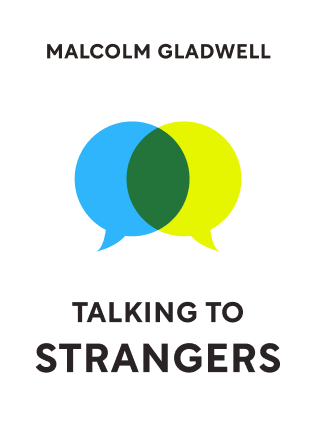

This article is an excerpt from the Shortform book guide to "Talking to Strangers" by Malcolm Gladwell. Shortform has the world's best summaries and analyses of books you should be reading.
Like this article? Sign up for a free trial here .
Why do we make assumptions about people, especially strangers? What are the consequences of the assumptions we make? Can we retrain ourselves and our interactions with strangers?
We’ll cover Malcolm Gladwell’s theory about why we make assumptions about people, from his book Talking to Strangers. As we’ll see, it’s not hard to correct this tendency.
Why Do We Make Assumptions About People?
Meeting a stranger can make it more challenging to make sense of that person than not meeting him. That’s because people assume transparency in others. This is why we make assumptions about people.
Transparency refers to the assumption that the way people present themselves outwardly (through behavior and demeanor) is an accurate and reliable representation of their inner feelings and intentions. But that’s an unrealistic assumption to make when dealing with strangers.
Before we explore further why we make assumptions about people, let’s look at how transparency works.
Transparency
Facial expressions are one of the primary ways that we interpret a stranger’s feelings (because we mistakenly assume that a person’s demeanor is an accurate representation of his feelings).
When we meet strangers, we tend to believe that they’ll be as transparent as the characters on Friends. This is the “Friends Fallacy.” It’s a fallacy because real life isn’t like an episode of Friends. In reality, strangers often aren’t transparent. So why do we assume they are? Why do we make assumptions about people?
Is Assuming Transparency Beneficial?
In The Expression of the Emotions in Man and Animals by Charles Darwin, Darwin argues that it is beneficial to human survival that people are able to quickly and accurately communicate emotions to one another.
The ability to smile, frown, and wrinkle the nose in disgust are some examples of how the human face evolved as a tool to represent internal feelings. This will probably strike you as a relatively obvious principle. After all, children everywhere naturally smile when they’re happy and frown when they’re sad, and that helps them get what they need to survive. So it seems reasonable to assume transparency. We make assumptions about people because we assume we can read their faces and body language.
But you should be careful not to assume that every stranger you come across will be transparent. That assumption about people requires everyone you meet to express themselves in the same predictable ways. Unfortunately, that is not the case.
Experiment: Transparency Across Different Cultures
Psychologist Carlos Crivelli spent years testing the limits of human transparency—he wanted to find out if people from entirely different cultures evolved to express the same emotions in the same ways. So in 2013, he teamed up with anthropologist Sergio Jarillo to conduct a social experiment in the remote Trobriands Islands.
Crivelli and Jarillo chose the Trobriands Islands because:
- The population is incredibly small and isolated. Only 40,000 people live on the archipelago, all of whom are removed from the 21st- century lifestyle. Crivelli and Jarillo were confident that any patterns of human behavior that were consistent in places like Madrid and the Trobriands could confidently be called universal behaviors.
- The Trobrianders have a rich and expressive language. They didn’t shy away from questions about nuances and emotional truths. This made them good subjects for a social experiment regarding human expression.
The experiment went like this:
- Crivelli and Jarillo showed school children in Madrid six photos of a person. Each photo conveyed a different expression: Happy, sad, scared, angry, disgusted, and neutral.
- The children were asked to identify which picture went with which emotion.
- Crivelli and Jarillo then went to the Trobriands Islands and showed the same photos to the people there. They asked the islanders to identify which picture went with which emotion.
- Crivelli and Jarillo examined the results of both groups to compare and contrast the difference of expression across the two groups.
The Results
- 100% of the Spanish school children accurately identified the photo with a happy expression, but only 58% of the Trobrianders identified the same photo as happy. (And the happy photo was the one that got the most similar results between the two groups.)
- The photo of what the Spanish children recognized as stereotypical fear was registered by the Trobrianders as a threatening expression.
- The photo that was meant to represent anger (with hard eyes, wrinkled brow, and tight lips) was completely confusing to the Trobrianders. 20% called it a happy face, 20% thought it was an expression of disgust, and 17% called it a sad face. In comparison, 91% of Spanish children correctly identified the photo as angry.
Clearly, the residents of the Trobriands Islands have an entirely different way of expressing familiar emotions than young children in Madrid. In other words, every human might experience the same emotions inwardly, but the way that emotion is expressed outwardly is very different from culture to culture.
If someone from the Trobriands Islands was to encounter a child from Madrid, the assumption of transparency would make it very difficult for the two strangers to understand one another. They would each make assumptions about people, and they’d be wrong.
Experiment: Making Assumptions About People within a Culture
Cultures that express emotions differently aren’t the only roadblocks to transparency. German psychologists Achim Schützwohl and Rainer Reisenzein created an experiment to test how consistent someone’s expression is with how he is feeling inwardly—that is, to test whether people are generally transparent. Are the assumptions about people with whom we share a culture correct? The experiment went like this:
- A participant is led down a long, very narrow hallway and into a dim room.
- The participant sits in the room, listens to a recording of a short story, and takes a memory test about it.
- While the participant is listening and being tested, a team disassembles the hallway outside the door to the room. They reset the scene outside the door as a wide-open area with green walls and a bright red chair. The participant’s best friend sits in the red chair with a serious expression and waits for the participant to come out of the testing room.
- The participant exits the testing room, expecting to see the same hallway she walked through before. The participant is surprised to see herself in an entirely new setting.
- Schützwohl and Reisenzein read the participant’s facial expression with FACS.
- They then ask the participant to rate their level of surprise at the moment they came out of the testing room and saw the new scene.
The Results
When the 60 participants that went through this experiment rated their feelings of surprise at the moment they exited the testing room, the average score among all participants was 8.14, out of 10. They were truly shocked.
Schützwohl and Reisenzein then asked each participant if he thought that level of surprise registered on his face. Almost all of the participants were convinced that they made a transparent expression of surprise when exiting the testing room. But that wasn’t the case. Upon reviewing the recording, Schützwohl and Reisenzein determined that only 5% of participants made the stereotypical expression of surprise (eyes widen, eyebrows raise, jaw drops).
The participants overestimated their own transparency—they reasoned that if they felt surprised they must have also looked surprised. We make this assumption about ourselves, and we make assumptions about other people.
Transparency Is a Myth
Humans are not transparent—it’s all a myth. Because we have all watched the same TV shows, like Friends, and read the same novels where a character’s “jaw drops in surprise,” we have been conditioned to believe that there is only one expression associated with any particular emotion. But that is unrealistic.
In reality, it takes getting to know someone well to be able to read their outward demeanor accurately. Only then do you have a chance of making accurate assumptions about people. With a close friend, you come to understand their idiosyncratic expressions and what they mean to express. But when you encounter a stranger, you often have to make assumptions based on their expressions because you don’t have any personal experience with that person. But your assumptions are based on stereotypes, like Ross’s exaggerated facial expressions in Friends, that are usually wrong.
Example:
One day, George goes to take a shower. Suddenly, from the bathroom, he hears his wife scream. George runs to the kitchen and sees a man holding a knife to his wife’s throat. George is naked and wet from the shower, but he intimidatingly yells at the assailant, “Get out of here NOW.” The young man gets scared and flees the scene.
On the inside, George was absolutely terrified for his wife’s safety in that moment. But he didn’t show it on the outside. Maybe someone who knew him well would have been able to tell that George’s intimidating demeanor was his natural reaction to fear, but the assailant (a stranger) had no way to know that.
What did the assailant assume about George based on his intimidating expression—that he was dangerous, violent, cold, or something else completely? The intruder mistakenly assumed transparency (which was lucky for George and his wife). He made assumptions about people, and the incorrect assumptions worked in the couple’s favor.

———End of Preview———
Like what you just read? Read the rest of the world's best book summary and analysis of Malcolm Gladwell's "Talking to Strangers" at Shortform .
Here's what you'll find in our full Talking to Strangers summary :
- Why we don't understand strangers
- How to talk to strangers in a cautious way so you don't get fooled
- How Hitler deceived so many world leaders






